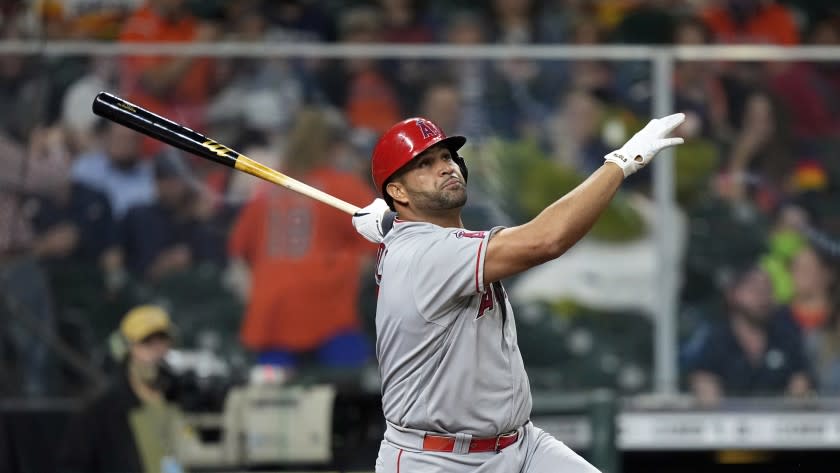Statistically speaking, Albert Pujols could do a number of things to help Dodgers

- Oops!Something went wrong.Please try again later.
Albert Pujols steadied his hands, shimmied his back elbow, then struck a pose.
If there’s one thing the 21-year veteran and future Hall of Fame slugger knows, it’s when he has gotten ahold of one.
And on April 26, just 10 days before being designated for assignment and later released by the Angels, Pujols had done so again, launching a 425-foot home run to straight-away center field in Arlington, Texas, against the Rangers.
It was Pujols’ 667th career home run and, at the time, fifth long ball through the 21st game of the season, representing a 38-homer pace if continued over the course of a 162-game campaign.
Pujols soon cooled off, going three-for-23 in his next six games with no extra base hits before the Angels cut him loose — a decision the team made believing they wouldn’t have enough future playing time for the former MVP.
On Saturday, however, the Dodgers apparently saw an opportunity with the 41-year-old. According to The Times’ Jorge Castillo, Pujols will be joining the defending World Series champions on a major-league deal for the remainder of the season.
Pujols’ limitations have become clear in recent years, injuries and age diminishing the skill set of one of baseball's most accomplished players. He has hit .245 or worse in each of the last five seasons. His OPS+ (an all-encompassing stat in which 100 is considered league average) has been just 85 during that same span, 15% below the league average.
He’s long past his Gold Glove caliber days defensively at first base, and has become the all-time leader in major-league history by grounding into 403 career double plays.
But the Dodgers in all likelihood won’t be asking Pujols to be an everyday player. Instead, he seems suited to fill a need on the bench: an extra right-handed bat with some power and plenty of experience.
To that end, Pujols displayed a few reasons for optimism in his 24 games with the Angels this year, beyond just his five home runs. Against left-handed pitching, he went seven-for-27 with three home runs, good for a .259 batting average, .878 on-base-plus-slugging percentage and 141 OPS+ in that split (meaning, Pujols was 41% better than the league-average hitter against lefties).
Some of his underlying numbers suggest he should have had more success. According to MLB’s Statcast System, Pujols’ average exit velocity, hard-hit percentage (balls with exit velocities of at least 95 mph) and barrel percentage (balls hit within an optimal range of exit velocity and launch angle) all ranked in the top half of the majors.
His expected batting average was .265 (67 points higher than his actual mark of .198). His expected slugging percentage was .513 (142 points higher than his actual mark of .372). And his batting average on balls in play was an unusually low .176, more than 100 points under the league average and a sign he might have been the victim of some bad luck.
From the start of spring training, he’d also received repeated praise from Angels manager Joe Maddon on his physical condition and the meticulous routine he would follow between games to help his body recover.
However, it still didn’t prevent underwhelming results. According to Fangraphs, Pujols’ total production was worth negative-0.3 wins above replacement. This season, the only Dodgers position player with a worse WAR is Edwin Ríos, and he’s set to undergo season-ending shoulder surgery.
But, in the specific part-time role it appears they will ask Pujols to play, the Dodgers have some reasons to be hopeful. And if it doesn’t work, it only will have cost them a prorated share of the $570,500 league minimum salary. The Angels, who released Pujols in the last year of his 10-year, $240 million contract, remain responsible for the remainder of his $30-million salary.
This story originally appeared in Los Angeles Times.

